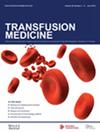Implementation challenges of electronic blood transfusion safety systems: Lessons from an international, multi‐site comparative case study
IF 1.4
4区 医学
Q3 HEMATOLOGY
引用次数: 0
Abstract
BackgroundSevere transfusion reactions resulting from errors in matching the correct blood with the correct patient are considered never events. Despite the relative technical simplicity of barcode scanning for patient‐blood bag matching, the adoption and universal application of this safety measure are by no means universal. This study highlights the logistical and institutional challenges associated with spreading, scaling up, and sustaining such IT‐supported safety measures in healthcare.Study Design and MethodsWe report findings from a 5‐year, prospective, multi‐site case study conducted across one hospital in England and three hospitals in the Netherlands. Ethnographic methods, including interviews and observations, were used at each site to investigate the implementation of barcode scanning‐supported safety pathways for blood transfusions.ResultsSignificant variation was observed across the sites in the adoption and implementation of barcode scanning‐supported safety pathways. Despite the potential for reducing transfusion errors, the introduction of this innovation was met with varying levels of success in different settings.DiscussionThis study highlights the critical role of inter‐hospital learning and flexible system design in successfully implementing barcode scanning‐supported safety pathways for blood transfusions. A more structured, national‐level network for knowledge sharing could enhance the spread and sustainability of such innovations across healthcare settings.输血安全电子系统的实施挑战:国际多站点比较案例研究的经验教训
背景由于错误地将正确的血液与正确的患者配对而导致的严重输血反应被认为是从未发生过的事件。尽管条形码扫描用于患者与血袋配血在技术上相对简单,但这一安全措施的采用和普遍应用却远未普及。本研究强调了在医疗保健领域推广、扩大和维持此类由信息技术支持的安全措施所面临的后勤和制度挑战。研究设计与方法我们报告了一项为期 5 年、前瞻性、多地点案例研究的结果,该研究在英国的一家医院和荷兰的三家医院进行。研究采用人种学方法,包括访谈和观察,对各医院实施条形码扫描支持输血安全路径的情况进行了调查。研究结果表明,各医院在采用和实施条形码扫描支持安全路径方面存在显著差异。讨论本研究强调了医院间学习和灵活的系统设计在成功实施条形码扫描支持的输血安全路径中的关键作用。一个更加结构化的国家级知识共享网络可以促进此类创新在医疗机构中的传播和可持续性。
本文章由计算机程序翻译,如有差异,请以英文原文为准。
求助全文
约1分钟内获得全文
求助全文
来源期刊

Transfusion Medicine
医学-血液学
CiteScore
2.70
自引率
0.00%
发文量
96
审稿时长
6-12 weeks
期刊介绍:
Transfusion Medicine publishes articles on transfusion medicine in its widest context, including blood transfusion practice (blood procurement, pharmaceutical, clinical, scientific, computing and documentary aspects), immunohaematology, immunogenetics, histocompatibility, medico-legal applications, and related molecular biology and biotechnology.
In addition to original articles, which may include brief communications and case reports, the journal contains a regular educational section (based on invited reviews and state-of-the-art reports), technical section (including quality assurance and current practice guidelines), leading articles, letters to the editor, occasional historical articles and signed book reviews. Some lectures from Society meetings that are likely to be of general interest to readers of the Journal may be published at the discretion of the Editor and subject to the availability of space in the Journal.
 求助内容:
求助内容: 应助结果提醒方式:
应助结果提醒方式:


